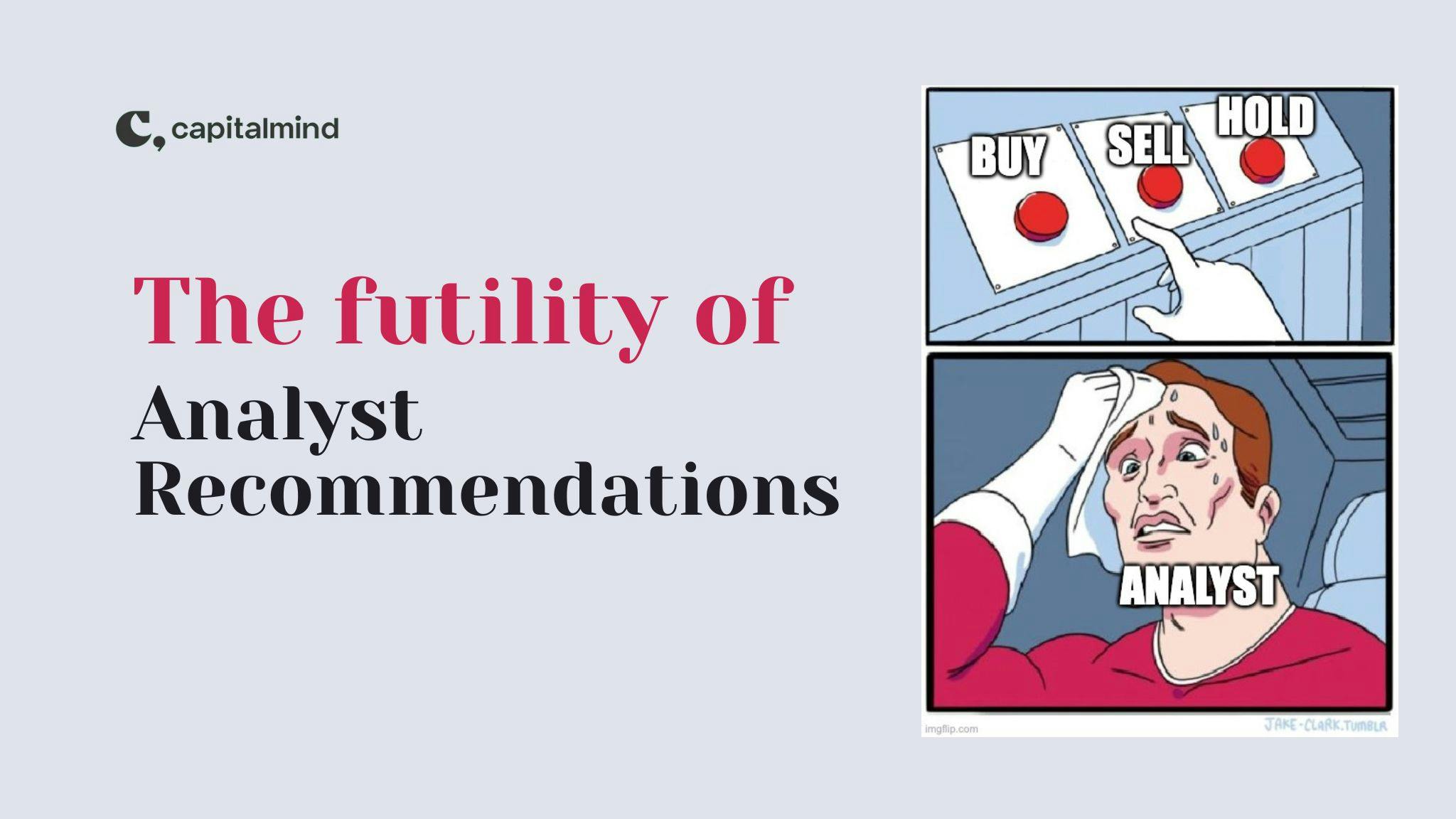(category)Commentary
The futility of analyst recommendationsThe futility of analyst recommendations
We analysed over 2,000 analyst recommendations (upgrades and downgrades) made by institutional equity analysts over the last ten years for the 50 Nifty stocks. We measured the 60-day return on the stock after the recommendation to see how those analyst recommendations fared. What we found: Since 2010, there have been 4x more upgrades than downgrades i.e. 1,638 upgrades versus 408 downgrades 63% of upgrades were followed by a higher stock price 60 days later. 55% of downgrades were followed by a lower stock price 60 days later. Overall, 61% of analyst recommendations were borne out by the direction the stock moved, but this is only part of the story Reliance, the largest Nifty component has the 3rd best overall quality of recommendations Tata Consumer Products, Apollo Hospitals, Bajaj FinServ were the others with decent analyst recommendation track records HDFC Life, UPL, BPCL, Nestle, and Wipro have had the worst quality recommendations Overall, only 50% of upgrades beat the Nifty over the next 60 days. 46% of downgrades did worse i.e. rose more or fell less than the Nifty. Investors relying haphazardly on buy and sell recommendations should revisit their investment process or better still just buy the index.
Anoop Vijaykumar•

What we found:
- Since 2010, there have been 4x more upgrades than downgrades i.e. 1,638 upgrades versus 408 downgrades
- 63% of upgrades were followed by a higher stock price 60 days later. 55% of downgrades were followed by a lower stock price 60 days later. Overall, 61% of analyst recommendations were borne out by the direction the stock moved, but this is only part of the story
- Reliance, the largest Nifty component has the 3rd best overall quality of recommendations
- Tata Consumer Products, Apollo Hospitals, Bajaj FinServ were the others with decent analyst recommendation track records
- HDFC Life, UPL, BPCL, Nestle, and Wipro have had the worst quality recommendations
- Overall, only 50% of upgrades beat the Nifty over the next 60 days. 46% of downgrades did worse i.e. rose more or fell less than the Nifty.
- Investors relying haphazardly on buy and sell recommendations should revisit their investment process or better still just buy the index.
Buys outnumber Sells
There were 2,046 recommendations for the 50 stocks, of which 80% (1,638) were upgrades and only the remaining 20% were downgrades.
That might seem lopsided but is common across markets, like the chart below for S&P500 stocks shows sells made up less than 10% of all analyst recommendations.

We see a lot more variation at the stock level in terms of number of upgrades versus downgrades.
Larsen & Toubro, Britannia, ICICI Bank, ITC and Power Grid Corporation have traditionally seen almost entirely positive reports about the prospects of their stock price. At the other end; JSW Steel, Wipro, Asian Paints Tata Consumer Products, ONGC have typically received up to (only) twice as many upgrades as downgrades. Grasim and SBI Life Insurance are not in the table since our data surprisingly indicated no downgrade reports for these two stocks.
What happens after upgrade and downgrades reports are published?
Average returns look good but stock-wise returns don't
Average absolute return 60 days after an upgrade is 6.6% and -5.2% after a downgrade. Does that mean analysts as a group get it very right? Maybe hold off on that conclusion just yet.
When you consider return relative to the Nifty, the positive and negative return both shrink significantly, because the market as a whole does not stand still and moves up over the long-term. So, a chunk of the positive returns are what the index and the broader market are doing anyway.
Even then, a 1.8% improvement on upgrades and 0.7% on downgrades is significant. If you managed that for every active decision you made, you'd be a rich investor over a couple of decades.
Averages hide individual variation. Chart below shows Nifty stocks on a scatterplot of average returns after downgrades and upgrades.
Reading this chart: Each bubble represents a current Nifty stock. The size of the bubble indicates the number of analyst recommendations over the last 10 or so years. The position of the bubble indicates the average 60-day return after upgrades and the average 60-day return after downgrades. Return after upgrades are on the y-axis and after downgrades on the x-axis. Returns are relative to Nifty. You can mouseover the bubbles to see the names of the stocks and corresponding mean returns.
For reference, the chart is divided into four quadrants. Quadrant I implies a reasonably positive return relative to the Nifty after upgrades and a relative negative return after downgrades. Quadrant III is the worst from an analyst credibility point of view, with negative returns after upgrades and positive returns after downgrades.
In a world where analysts got it mostly right, most points on that chart would be in Quadrant I, a few in IV and II and almost none in III. But the data shows otherwise.
Consider the three at the top of Quadrant I, Bajaj Finserv, Apollo Hospitals, and Tata Consumer Products with significantly positive returns after upgrades and mildly negative returns after downgrades. Following analyst recommendations for these stocks would have helped outperform the Nifty. But note how their bubble sizes are small which means they don't have as many reports as some of the other stocks.
Conversely, consider some of the stocks in Quadrant III; UPL, Hindustan Unilever, HCL Tech which show significantly positive returns after downgrades and close to nothing after upgrades. You'd have been better off doing the opposite of analyst recommendations for these stocks.
The scattershot nature of this chart should give anyone investing based on Buy and Sell recommendations to pause and examine their process.
But there's still a problem in looking at averages. Sharp moves on a few recommendations might skew the overall "rightness" for a stock.
What if we assigned a "Quality" score based on how many recommendations move in the forecast direction? A stock that moves up after a buy or overweight recommendation makes for a quality recommendation, and the opposite holds true for a sell recommendation.
Chart shows the individual Nifty stocks based on the quality of upgrade and downgrade recommendations.
Mouse over the chart to see stock names.
The best a stock can do is 100 on either axis. We'd have liked to see a cluster on the top right of the chart and none in the bottom left. Instead the centre of mass of the plot is somewhere below the halfway mark on both axes. Some stocks like Tata Consumer Products, Reliance, Maruti, Apollo Hospitals seem to have got reasonably timely recommendations to both enter and exit. Recommendations for stocks like HDFC Life, UPL, Nestle, BPCL have been way off.
The cluster on the zero line UPL, ITC, L&T, Power Grid have had the worst quality of downgrade calls. SBI Life and Grasim have no downgrade data. Interestingly, Power Grid, which had only one downgrade, fell 17% in the period after the downgrade, but still outperformed the Nifty by 4%.
Table below brings the recommendation quality scores together, both absolute and relative to Nifty.
Overall Recommendation Quality score is simply = Recommendations that moved right / Total # Recommendations.
Summing up
Any frame of analysis has its drawbacks. Is 60 (trading) days a fair duration to judge the quality of individual stock recommendations? Should it be longer? Maybe, but a lot of analysts follow a quarterly report cadence revisiting their views after quarterly results so it makes some sense.
Maybe research recommendations are more relevant to the mid and smallcap universe given the companies we've considered are the most followed in India.
Also our analysis probably misses a few reports, though 2,000+ is a decent sample size. Here's what we end up with.
At an absolute level, you'd be up 63% of the time on upgrades, and 55% on downgrades. But the point of active stock-picking is to beat the much lower-stress alternative of buying the index.
If your intent was to beat the index, following analyst recommendations diligently would be too much like a coin-toss.
Buying and selling individual stocks based on research reports adds activity and costs but not necessarily incremental returns.
At a minimum, read the next analyst Buy or Sell recommendation with healthy skepticism. Don't forget to apply that same skepticism to your own views on individual stocks about where they are headed.
Even better, reconsider your investment process if it depends on research recommendations, or just do the unsexy but likely more lucrative thing and buy the index.
Relevant and Recommended further reading:
Common-sense position sizing for investors
Where do superhero (10x) stocks come from?
How the best investors deal with being wrong
On Market timing: What if you were the luckiest investor in India?
This post is for informational purposes only and is not a recommendation to buy or sell stocks.
Related Posts
Make your money work as hard as you do.
Talk to a Capitalmind Client AdvisorInvesting is not one size fits all
Learn more about our distinct investment strategies and how they fit into your portfolio.
Learn more about our portfoliosUnlock your wealth potential
Start your journey today



